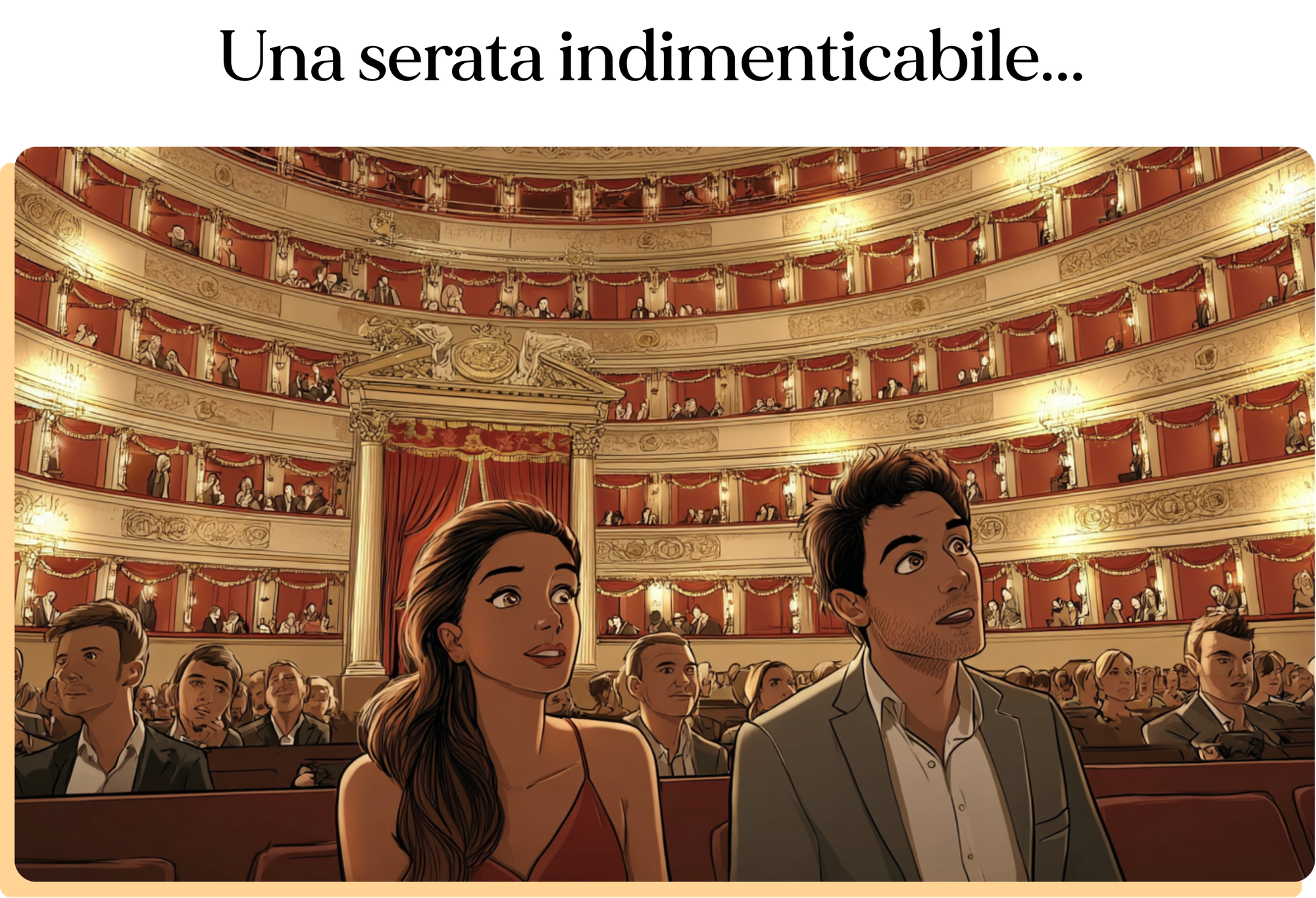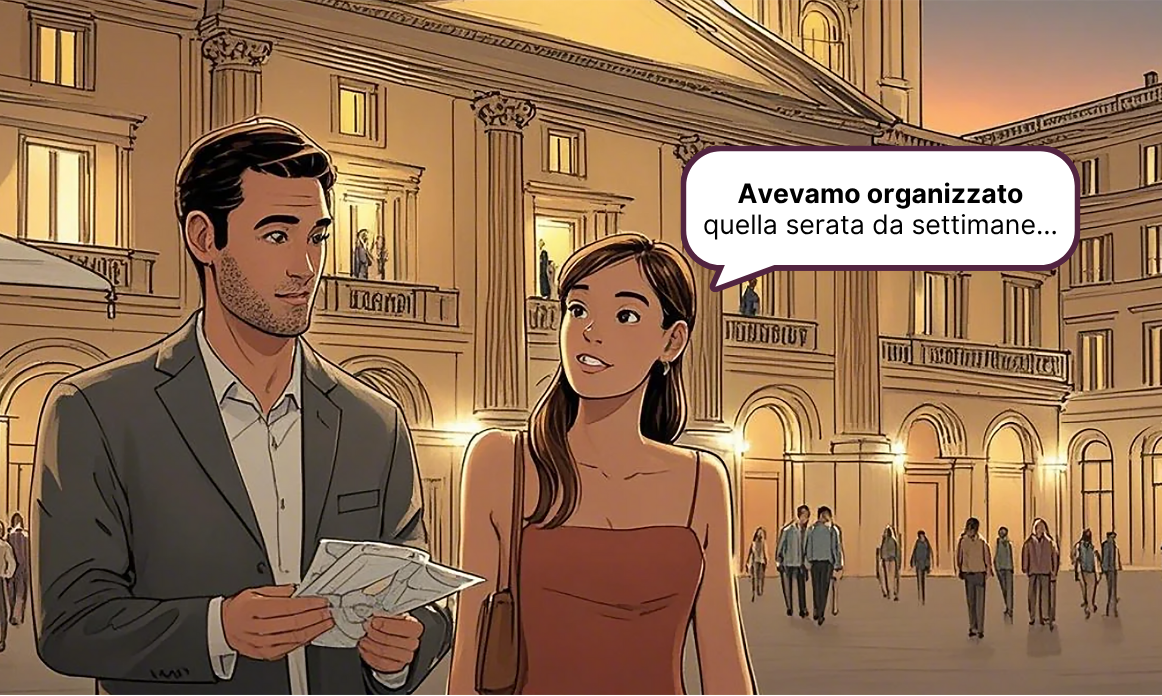Intro.
The trapassato prossimo is a past tense that expresses an action completed before another past action. It answers the question What had already happened before?
From a narrative perspective, the trapassato prossimo is a verb tense that allows you to enrich the rhythm of storytelling and make narration more dynamic, creating surprise and curiosity, emotional tension and suspense.
Example:
Pensavo di aver perso il portafoglio, ma poi ho scoperto che l'avevo lasciato a casa.
I thought I had lost my wallet, but then I found out I had left it at home.
In this sentence, the trapassato prossimo conveys the tension of the moment when one believed they had lost something important and, at the same time, the final relief of having found it.
1. Formation of the Trapassato Prossimo
The trapassato prossimo is formed as follows:
- the imperfect of the auxiliary verb essere or avere + the past participle of the verb.
| Person | With AVERE | With ESSERE |
|---|---|---|
| (io) | avevo parlato | ero andato/a |
| (tu) | avevi parlato | eri andato/a |
| (lui/lei) | aveva parlato | era andato/a |
| (noi) | avevamo parlato | eravamo andati/e |
| (voi) | avevate parlato | eravate andati/e |
| (loro) | avevano parlato | erano andati/e |
2. Functions and Uses of the Trapassato Prossimo
The trapassato prossimo is a verb tense used to indicate an action that occurred before another action in the past: the reference point of the narration is in the past, and events or facts that happened before are expressed with the trapassato prossimo.
It is used together with other past tenses like the passato prossimo or imperfetto.
Examples:
Quando sono arrivato, Giorgia aveva già cenato.
When I arrived, Giorgia had already had dinner.
Non volevo fare l'esercizio che la professoressa ci aveva assegnato.
I didn’t want to do the exercise the teacher had assigned us.
2.1 Trapassato Prossimo Introduced by che
As a relative pronoun, che (and cui preceded by prepositions) often introduces dependent relative clauses that use the trapassato prossimo to describe actions that occurred before the action described in the main clause:
Examples:
Ho perso il cappello di paglia che avevo comprato in Grecia.
I lost the straw hat I had bought in Greece.
→ first I bought the straw hat in Greece, then I lost it.
Ho conosciuto finalmente Paul di cui avevo sentito parlare tanto.
I finally met Paul, whom I had heard so much about.
→ previously I had heard so much about Paul, then I met him.
As a conjunction after expressions like ho saputo, ho capito, ho sentito dire, mi hanno detto and others, che is often followed by the trapassato prossimo to indicate facts or events that occurred previously to the moment of knowing, understanding, hearing, saying, etc.:
Example:
Ho capito che erano entrati i ladri quando ho trovato tutto in disordine.
I realized that the thieves had broken in when I found everything in disorder.
2.2 Trapassato Prossimo in Temporal Clauses
The trapassato prossimo in temporal clauses expresses the anteriority of an event with respect to another past event.
It is frequently introduced by specific temporal indicators such as appena, non... ancora, già, da poco + trapassato prossimo followed by a clause in the passato prossimo (or imperfetto) introduced by quando:
- appena; indicates an action completed recently.
Example:
Avevo appena finito di studiare, quando i miei amici mi hanno chiamato per uscire.
As soon as I had finished studying, my friends called me to go out.
- non... ancora; indicates that an action had not yet been completed at a reference moment in the past.
Example:
Quando mi hai chiamato, non avevo ancora finito i compiti.
When you called me, I hadn't finished my homework yet.
- già; indicates that an event had already happened before another in the past.
Example:
Quando abbiamo acceso la TV, il film era già cominciato.
When we turned on the TV, the movie had already started.
- trapassato prossimo + da poco; indicates that an action had just finished shortly before another action in the past.
Example:
Avevo finito di mangiare da poco, quando mi hanno invitato a cena.
I had just finished eating when they invited me to dinner.
- dopo che + trapassato prossimo. Expresses an action completed before the main action, emphasizing temporal succession.
Example:
Dopo che avevamo sistemato la casa, siamo usciti.
After we had tidied up the house, we went out.
Note: When the subject of both actions is the same, it is preferable to use dopo + past infinitive instead of dopo che + trapassato prossimo.
Examples:
Dopo aver mangiato, sono andato a correre. (same subject: io)
After eating, I went for a run.
Dopo aver finito l'università, ha trovato subito lavoro. (same subject: lui/lei)
After finishing university, he immediately found a job.
2.3 Trapassato Prossimo in Causal Clauses
The trapassato prossimo in causal clauses expresses the cause anterior to the effect of the event expressed in the main clause. It establishes a clear logical-temporal relationship between cause and effect.
Among the most frequent causal conjunctions that introduce the trapassato prossimo are siccome, perché, poiché + trapassato prossimo. Siccome is always found at the beginning of the sentence; perché is found in the second part of the sentence; poiché can be found either at the beginning or in the second part of the sentence:
- siccome + trapassato prossimo;
Example:
Siccome avevo dimenticato l'ombrello, mi sono bagnato.
Since I had forgotten my umbrella, I got wet.
→ first I forgot my umbrella, then I got wet.
- perché + trapassato prossimo;
Example:
Era nervoso, perché aveva litigato con sua sorella.
He was nervous because he had argued with his sister.
→ first he argued with his sister, then he became nervous.
- poiché + trapassato prossimo. Poiché has the same value as both siccome and perché but is more formal.
Examples:
Poiché avevo perso l'autobus, ho preso un taxi.
Since I had missed the bus, I took a taxi.
Ho preso un taxi, poiché avevo perso l'autobus.
I took a taxi since I had missed the bus.
→ first I missed the bus, then I took a taxi.
2.4 Trapassato Prossimo in Spoken Language
If the two actions expressed in the sentence are perceived by the speaker as very close, in living use of the language there is a tendency to use the passato prossimo instead of the trapassato prossimo.
Examples:
Ho letto il libro che mi hai regalato.
I read the book you gave me as a present.
→ instead of the grammatically more correct: Ho letto il libro che mi avevi regalato.
Era arrabbiato perché hai preso la sua bici.
He was angry because you took his bike.
→ instead of: Era arrabbiato perché avevi preso la sua bici.
3. Combined Use of Trapassato Prossimo, Passato Prossimo and Imperfetto in Narration
In a story, the trapassato prossimo naturally interweaves with other past tenses like the passato prossimo and imperfetto. Each tense has a specific function in narration:
- imperfetto sets the scene and describes how the situation was ongoing in the past;
- passato prossimo introduces the main narrative events;
- trapassato prossimo expresses concluded past actions, previous to other past actions.
Consider the actual temporal sequence of these events:
- Ho chiuso il cancello (the day before).
- Qualcuno ha lasciato nuove impronte.
- Ho sentito un rumore. - Reference point in the past
- Sono uscito.
- Il cancello era aperto.
- Mi sono guardato attorno e non c'era nessuno.
- Ho guardato a terra.
- Ho visto le impronte.
Observe the combination of the same events within the story:
The trapassato prossimo gives depth to the story, inserting previous events that explain or complicate the narration. It creates more complex narrative plots, generating suspense or inserting plot twists in mysterious situations.
4. Trapassato Prossimo in Context: Italian Short Story
This short story demonstrates how the trapassato prossimo works naturally within Italian narrative, showing the interplay between different past tenses to create depth and timeline clarity.

Avevamo organizzato quella serata da settimane, io e Lorenzo: cena leggera e poi La Bohème, un’opera che avevamo sempre desiderato vedere, ma che non avevamo mai avuto occasione di seguire dal vivo.
Alle 18:30 ero pronta. Lorenzo mi ha raggiunto mezz’ora dopo, puntualissimo. «Hai preso i biglietti?», ho chiesto (con Lorenzo non si sa mai cosa aspettarsi!). «Tutto sotto controllo!» ha risposto sicuro. «Abbiamo programmato questa serata da oltre un mese!».
Dopo cena, ci siamo avviati con calma verso il teatro. Sembrava una di quelle serate perfette, pensate nei minimi dettagli…almeno fino all’ingresso!
Una volta all’entrata, Lorenzo ha tirato fuori con disinvoltura i biglietti dalla tasca interna della giacca. Ma il sorriso dell’addetto, un ragazzo giovane con l’aria gentile ma un po’ impacciata, si è spento quasi subito dopo aver guardato i biglietti. Ha aggrottato la fronte, controllato di nuovo, poi digitato qualcosa al computer.
«Mi dispiace…» ha detto, sollevando lo sguardo con una punta di esitazione, «ma questi biglietti sono per sabato prossimo.»
Per un attimo, il silenzio. Io l’ho guardato, poi ho guardato Lorenzo che nel frattempo aveva già tirato fuori il telefono, cercando freneticamente l’e-mail di conferma. «È impossibile, ho acquistato i biglietti settimane fa! Avevo controllato tutto con attenzione, prima di confermare la prenotazione!» Ma la verità era sotto i nostri occhi: sabato 20 giugno. E quella sera era il 13.
«L’unica possibilità è una disdetta dell’ultimo minuto», ha poi aggiunto il ragazzo. «Potete aspettare qui accanto, se volete.»
Abbiamo atteso speranzosi nell’atrio. Il tempo passava, io mi ero seduta su un gradino, con la borsa sulle ginocchia e Lorenzo continuava a scusarsi.
Le porte della sala si erano chiuse e io avevo ormai rinunciato, quando il ragazzo della biglietteria è tornato da noi con un sorriso: «Due persone non si sono presentate. Terza fila, centrale. Se volete, possiamo fare un cambio di prenotazione.»
Non abbiamo esitato un solo istante. In pochi secondi eravamo in sala.
Una volta dentro, l’orchestra aveva appena finito di accordare gli strumenti. La vista era perfetta. Io ho tirato un lungo sospiro di sollievo, ancora incredula. Lorenzo, invece, si era già sistemato comodamente sulla poltrona, in tutta tranquillità.
«Vediamo il lato positivo…» ha poi sussurrato «non ho sbagliato l’Opera… e siamo pure capitati in terza fila! Te l’avevo detto che era tutto sotto controllo!»
5. Test Your Knowledge: Grammar Quiz
Test your skills and see what you’ve learned from this lesson on the Italian Trapassato Prossimo by completing the following quiz.
6. Frequently Asked Questions (FAQ) 🙋♀️
When do you use the trapassato prossimo instead of the passato prossimo?
The trapassato prossimo is used when we want to express an action that occurred before another past action. The passato prossimo expresses an action concluded in the past without reference to another anterior action.
Is it always mandatory to use the trapassato prossimo to express anteriority?
No, when a past action has a strong connection with the present or is perceived as "close," you can use the passato prossimo for both clauses: Ho letto il libro che mi hai dato instead of Ho letto il libro che mi avevi dato.
What is the difference between dopo che + trapassato and dopo + past infinitive?
You use dopo che + trapassato when the subjects of the two actions are different. You use dopo + past infinitive when the subject is the same in both actions.

Adriana Rossi is a certified teacher of Italian as a foreign language from Rome, Italy, and has been part of the Giulia team since 2024. With a Modern Literature degree and advanced studies in Modern Philology, she specializes in tracing the origins and evolution of Italian words, bringing expertise in diction and expressive reading to help preserve and share Italy’s linguistic heritage with learners worldwide.





